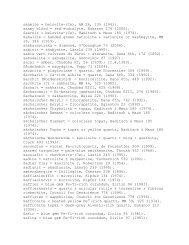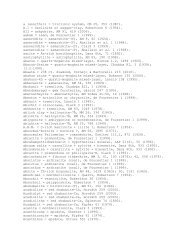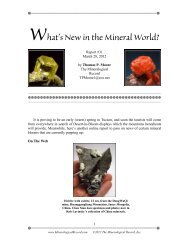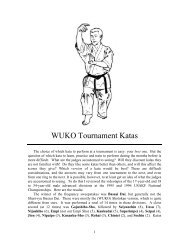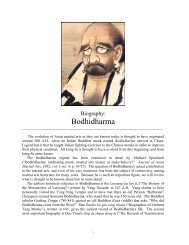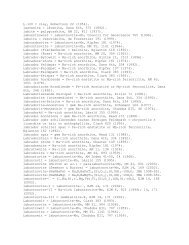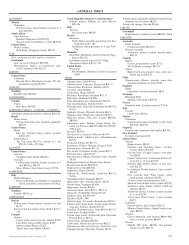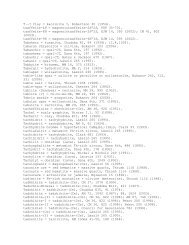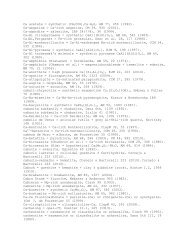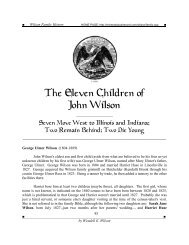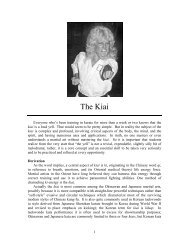136 Figure 15. <strong>Cuprian</strong> elbaite scepter crystal, 2 cm, from the Batalha mine. Michael Scott collection; Van Pelt photo courtesy of Michael Scott. Finally, it should be noted as a warning that some marketers have been offering blue-to-green copper-free tourmaline as Paraíba tourmaline in order to obtain a much higher price CONCLUSIONS Although the area in northeastern Brazil where occurrences of cuprian elbaite have been found is fairly large, none of the localities has produced crystals equal to those found at the Batalha mine. Furthermore, almost all good crystals of any size tend to be shattered, and the remainder are generally embedded, non-gemmy and not of good collector quality. As long as mining continues in the area, the possibility of more good crystals being found exists, but their extremely high gem value probably means that most will continue to be cut as gemstones rather than saved as crystal Figure 17 . <strong>Cuprian</strong> elbaite crystal section, 1.5 cm, turquoise-blue with purple core, from the Batalha mine (ca. 1989). Brian Cook specimen; Wendell Wilson photo. Figure 16. Faceted cuprian elbaites showing a range of color. Michael Scott collection; Van Pelt photo courtesy of Michael Scott. specimens. Consequently, even very small crystals of good color, form and transparency will probably remain very rare in collections and on the market. ACKNOWLEDGMENTS I am grateful to Brendan Laurs and James Shigley (Gemological Institute of America) and Anthony Kampf (Natural History Museum of Los Angeles County) for reviewing the manuscript, and for graciously providing information and photos. Brian Cook (Nature’s Geometry) also provided information and loaned specimens for photography. BIBLIOGRAPHY ADUSUMILLI, M. S., CASTRO, C., and BHASKARA RAO, A. (1994) Blue and green gem tourmaline from Gregório pegmatite, Rio Grande do Norte State. In: 16th General Meeting of the International <strong>Mineralogical</strong> Association, Pisa, Italy, 1–13. ALMEIDA, F. F. M., HASUI, Y., BRITO NEVES, B. B., AND FUCK, R. A. (1981) Brazilian structural provinces: an introduction. Earth Science Review, 17, 1–29. AUSTIN, G. T. (2001) Reviving a legend. Colored Stone, 14 (1), 510–511. BANK, H., and HENN, U. (1990) Paraíba tourmaline: beauty and rarity. Jewellery News Asia, no. 70, 62, 64. BANK, H., HENN, U., BANK, F. H., von PLATEN, H., and HOFMEISTER, W. (1990) Leuchtendblaue Cu-führende Turmaline aus Paraíba, Brasilien. Zeitschrift der Deutschen Gemmologischen Gesellschaft, 39 (1), 3–11. BARBOSA, H., and COOK, B. C. (1991) Copper tourmaline from Paraíba, Brazil. Privately printed circular, 1 p. BRANDSTÄTTER, F., and NIEDERMAYR, G. (1993) Einschlüsse von gediegen Kupfer in Cu-elbaite von São José da Batalha, Paraíba, Brazilien. Zeitschrift der Deutschen Gemmologischen Gesellschaft, 42 (1), 37–41. BRANDSTÄTTER, F., and NIEDERMAYR, G. (1994) Copper <strong>The</strong> <strong>Mineralogical</strong> <strong>Record</strong>, volume 33, March–April, 2002
and tenorite inclusions in cuprian-elbaite tourmaline from Paraíba, Brazil. Gems & Gemology, 30 (3), 178–183. COOK, B. C., and BARBOSA, H. D. (1999) Copper tourmaline of Paraíba, Brazil; reopening of the mine; regional exploration. [Abstract] in Proceedings of the third International Gemological Symposium. Gems & Gemology, 35 (3), 138. FALSTER, A. U., SIMMONS, W. B., NIZAMOFF, J. W., and WEBBER, K. L. (2000) <strong>Cuprian</strong> elbaite from the Bocheirão Zinho pegmatite, Paraíba, Brazil (Abstract). <strong>Mineralogical</strong> <strong>Record</strong>, 31, 181–182. FEDERMAN, D. (1990) Gem profile. Paraíba tourmaline: toast of the trade. Modern Jeweler, 89 (1), 48. FRITSCH, E., SHIGLEY, J. E., ROSSMAN, G. R., MERCER, M. E., MUHLMEISTER, S. M., and MOON, M. (1990) Gemquality cuprian-elbaite tourmalines from São José da Batalha, Paraíba, Brazil. Gems & Gemology, 26 (3), 189–205. HAUGHTON, S. H. (1969) Geological History of Southern Africa. Geological Society of South Africa, Cape Town, 535 p. HENN, U., and BANK, H. (1990) On the colour and pleochroism of Cu-bearing green and blue tourmalines from Paraíba, Brazil. Neues Jahrbuch für Mineralogie, Monatshefte, no. 6, 280–288. HENN, U., BANK, H., BANK, F. H., PLATEN, H., and HOF- MEISTER, W. (1990) Transparent, bright blue Cu-bearing tourmalines from Paraíba, Brazil. <strong>Mineralogical</strong> Magazine, 54, 553– 557. KANE, R. (1989) Gem trade lab notes: Blue tourmaline from Brazil. Gems & Gemology, 25 (4) 241–242. KARFUNKEL, J., and WAGNER, R. R. (1996) Paraíba tourmalines: distribution, mode of occurrence and geologic environment. Canadian Gemmologist, 17 (4), 99–106. KOIVULA, J. I., and KAMMERLING, R. C. (1989a) Gem news: Unusual tourmalines from Brazil. Gems and Gemology, 25 (3), 181–182. KOIVULA, J. I., and KAMMERLING, R. C. (1989b) Gem news: Paraíba tourmaline update. Gems & Gemology, 25 (4), 248. KOIVULA, J. I., and KAMMERLING, R. C. (1990) Gem news: <strong>The</strong> discovery of the Paraíba tourmaline mine. Gems & Gemology, 26 (2), 164–165). KOIVULA, J. I., and KAMMERLING, R. C. (1991a) Gem news: Paraíba tourmaline. Gems & Gemology, 27 (1), 51. <strong>The</strong> <strong>Mineralogical</strong> <strong>Record</strong>, volume 33, March–April, 2002 KOIVULA, J. I., and KAMMERLING, R. C. (1991b) Gem news: Large Paraíba tourmalines. Gems & Gemology, 27 (3), 184. KOIVULA, J. I., KAMMERLING, R. C., and FRITSCH, E. (1992a) Gem news: Tourmaline from Paraíba, Brazil. Gems & Gemology, 28 (1), 62. KOIVULA, J. I., KAMMERLING, R. C., and FRITSCH, E. (1992b) Gem news: Tourmaline with distinctive inclusions. Gems & Gemology, 28 (3), 204. KOIVULA, J. I., KAMMERLING, R. C., and FRITSCH, E. (1993) Gem notes: Tourmaline from Paraíba, Brazil. Gems & Gemology, 29 (1), 62–63. KOIVULA, J. I., KAMMERLING, R. C., and FRITSCH, E. (1994) Gem news: Miscellaneous notes on tourmaline. Gems & Gemology, 30 (1), 55. LAURS, B. M., and SHIGLEY, J. E. (2000) Gem news: Paraíba tourmaline update. Gems & Gemology, 36 (3), 269–271. ROBINSON, G. W., and WEGNER, R. R. (1998) Mineralogy of the Boqueirãozinho pegmatite, Parelhas, Rio Grande do Norte, Brazil. <strong>Mineralogical</strong> <strong>Record</strong>, 29, 193–197. ROSSMAN, G. R., FRITSCH, E., and SHIGLEY, J. E. (1991) Origin of color in cuprian elbaite from São José da Batalha, Paraíba, Brazil. American Mineralogist, 76 (9/10), 1479–1484. ROY, L. R., DOTTON, O., and MADON, H. L. (1964) Estudos dos pegmatitos do Rio Grande do Norte e da Paraíba. Sudene, Dept. de Recursos Naturais Divisão Geologia, serie geologia economica No. 1. SHIGLEY, J. E., COOK, B. C., LAURS, B. M., and BERNARDES, M. O. (2001) An update on Paraíba tourmaline from Brazil. Gems & Gemology, 37 (4), 260–276. SOARES, D. R., FERREIRA, A. C. M., RODRIGUES DA SILVA, R., and FERREIRA, V. P. (2000) Alkali-deficient elbaite from pegmatites of the Seridó region, Borborema Province, NE Brazil. Revista Brasileira de Geociências, 30 (2), 293–296. WILSON, W. E. (1991) What’s new in minerals? Tucson Show 1991. <strong>Mineralogical</strong> <strong>Record</strong>, 22, 217, 219. ZANG, J. W., and DA FONSECA-ZANG, W. A. (2001) Cu-haltige <strong>Elbaite</strong> aus Nigeria. Berichte der Deutschen Mineralogischen Desellschaft, Beihefte zum European Journal of Mineralogy, 13, 202. 137



